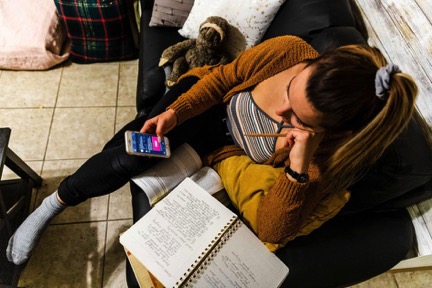Control often has benefits. It can create a sense of structure, predictability, mastery, and safety.
As we know, none of us are in control of everything. We have all experienced unwanted internal and external experiences. If we knew how to control everything, we would probably start there. Although we may not have a choice about all of the events that unfold in front of our eyes or within our bodies, we actually can control some of our responses to reduce suffering.

Let peace begin with curiosity
Start by understanding what you are actually experiencing. Many individuals with social anxiety may respond by wanting to avoid, push away, or eliminate the emotion (Barlow et al., 2011). This response means you are already caught in conflict! If we stop and get curious about what we are experiencing we can actually take the first step in reducing our suffering.
Research has shown that labeling emotions is a way to decrease emotional intensity and increase the activity in the part of our brain responsible for thinking (Creswell, Way, Eisenberger & Lieberman, 2007). This is as straightforward as stopping to get curious instead of immediately running away from unwanted sensations.
You can do this by allowing yourself to label your emotion by saying, “I feel scared,” “I am anxious,” or “I am nervous.”
Let peace begin with connection
Anxiety is a valuable emotion that we all experience. It helps give us information about our environment to keep us safe. There are natural, biological responses to activation of our sympathetic nervous system (Barlow et al., 2011; Hayes, 2005; Linehan, 2015)
Social anxiety usually shows up in response to a situation that involves others. If you are caught in the conflict to eliminate anxiety, you might scan for potential mistakes or threats. You may notice thoughts like “I don’t have anything interesting to say,” or “I can’t tolerate being anxious.” But what if having these thoughts didn’t mean you were different or flawed in some way?
Anxious feelings may just mean that social connection is important, rather than meaning we are in danger or at risk of social isolation. This is actually a moment of opportunity to remind ourselves that experiencing pain connects us with others (Neff, 2011; Neff & Germer, 2018).
This could be a simple phrase such as “It makes sense that I am nervous, this is important to me,” or “Others experience anxiety when they are giving presentations, just like me.”

Let peace begin with kindness
Actions in-line with anxiety include those related to fighting, fleeing, or freezing. If danger is present, it may be effective to act on the emotion of fear by keeping safe or protecting what is valuable to us. This might mean getting out of a dangerous situation or jumping into action in service of your beliefs, values or others.
When social anxiety shows up, acting on the emotion may not be as helpful. We may actually be prolonging the suffering by attacking ourselves! What if you ended the conflict by offering yourself kindness instead of criticism? Are there things about social interaction that are neutral or going well? If a friend were in a similar situation, what details might you notice or relay to them (Neff, 2011; Neff & Germer, 2018)?
This might be an encouraging phrase you would tell a friend, such as “You got this!” or “I can tell how much effort you put into this.” It could also be in the form of fortifying yourself with a pleasurable activity like taking a walk, drinking your favorite tea, or volunteering (Linehan, 2015).
Let peace begin with you
Although these steps will not eliminate anxiety all together, they may be helpful ways to stop an internal conflict and strengthen more compassionate responses.
Written by,
Michelle Dexter, Ph.D.
National Social Anxiety Center of Los Angeles











